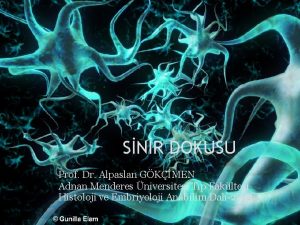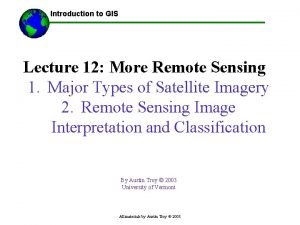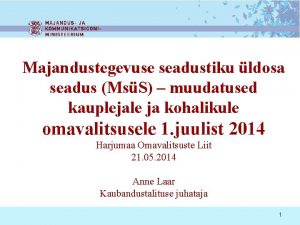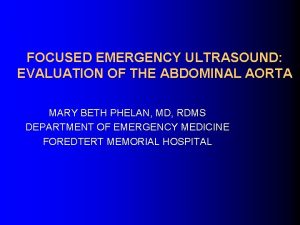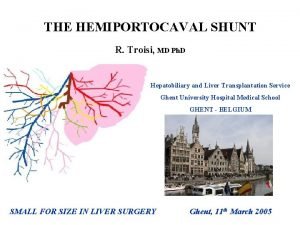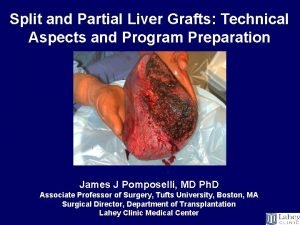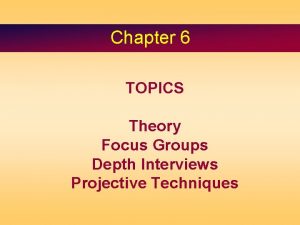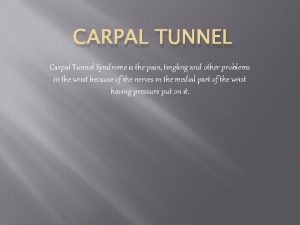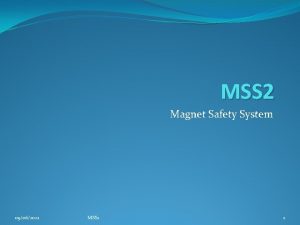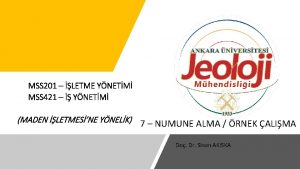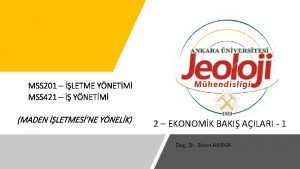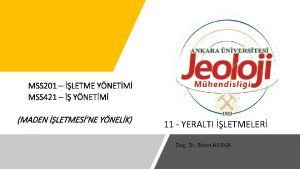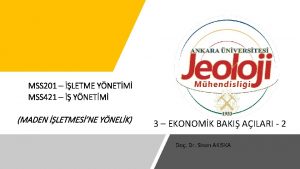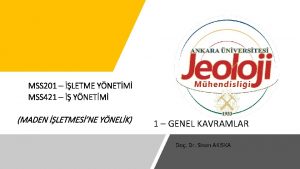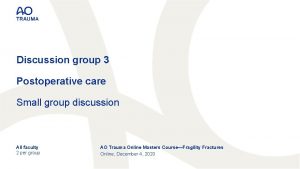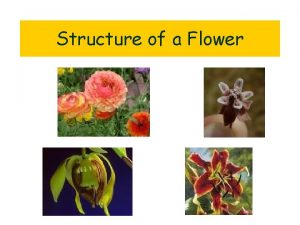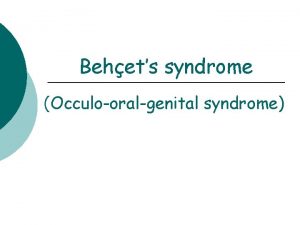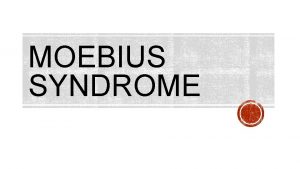MSS MODULE Carpel Tunnel Syndrome Small Group Discussion




























- Slides: 28

MSS MODULE Carpel Tunnel Syndrome “Small Group Discussion” By Prof. Dr. Zainalabideen A. Al-Abdulla, MRCPI, DTM&H. , Ph. D. , FRCPath. (U. K. )

A 40 -years-old woman visited her physician complaining of severe burning pain "pins and needles" in the hand lateral fingers. The condition was becoming progressively worse and was more severe at night. She said she had experienced difficulty in buttoningup her clothes when dressing.

On physical examination, the patient pointed to the thumb, index, middle, and lateral half of the ring fingers as the area where she felt the discomfort. No objective impairment of sensation could be detected over thenar muscle. However the sensation was mildly decreased in the lateral three and half finger. The muscles of thenar eminence appeared to have some wasting with less power compared to the other muscle of the hand manifested by weakness of resisted thumb abduction.

QUESTIONS Q- What anatomic structure was diseased in this patient? Q- Explain the altered sensation felt in the skin over the palmer aspect of the lateral three and half finger. Q- Explain the absence of paresthesia over the palmer aspect of thenar eminence. Q- Explain the difficulty she experienced in the buttoning up her clothes.

Carpal tunnel syndrome (CTS), or median neuropathy at the wrist, is a medical condition in which the median nerve is compressed at the wrist, leading to paresthesias, numbness and muscle weakness in the hand. Night symptoms and waking up at night are characteristic of established carpal tunnel syndrome. They can be managed effectively with nighttime wrist splinting in most patients. The definitive treatment for carpal tunnel syndrome is carpal tunnel release surgery.

The median nerve passes through the carpal tunnel, a canal in the wrist that is surrounded by bones on three sides, and a transverse carpal ligament (flexor retinaculum) on the fourth. Nine tendons; the flexor tendons of the hand pass through this canal. The median nerve can be compressed by a decrease in the size of the canal, an increase in the size of the contents (such as the swelling of lubrication tissue around the flexor tendons), or both. Simply flexing the wrist to 90 degrees will decrease the size of the canal.


Compression of the median nerve as it runs deep to the transverse carpal ligament (TCL) causes wasting of thenar eminence, weakness of the flexor pollicis brevis, opponens pollicis, abductor pollicis brevis, as well as sensory loss in the distribution of the median nerve distal to the transverse carpal ligament. There is a superficial sensory branch of the median nerve, which branches proximal to the TCL and travels superficial to it. This branch is therefore spared, and it innervates the palm towards the thumb



Symptoms appear when sleeping and typically include numbness and paresthesia (a burning and tingling sensation) in the thumb, index, and middle fingers, although some patients may experience symptoms in the palm • These symptoms appear at night because people tend to bend their wrists when they sleep. • Patients note that they "drop things". Also, it does decrease sweating, which decreases friction between an object and the skin.

In early stages of CTS individuals often mistakenly blame the tingling and numbness on restricted blood circulation. They may also be at ease and accepting of the symptoms and believe their hands are simply “falling asleep”. In chronic cases, there may be wasting of thenar muscles (the body of muscles which are connected to the thumb), weakness of palmar abduction of the thumb (difficulty bringing the thumb away from the hand).

Absence of significant numbness or paresthesia is NOT likely to fall under CTS

CTS characterized by numbness, not pain

Carpal tunnel syndrome can be misdiagnosed, and other syndromes misdiagnosed as carpal tunnel syndrome. So: Nerve conduction study or referral to a neurologist may be of benefit in clarifying the diagnosis.

Causes Most cases of CTS are idiopathic. CTS is sometimes associated with trauma, pregnancy, multiple myeloma, amyloidosis, rheumatoid arthritis, acromegaly, mucopolysaccharidoses, hypothyroidism Genetic The most important risk factors for carpal tunnel syndrome are structural and biological rather than environmental or activity-related. The strongest risk factor is genetic predisposition

Diagnosis • The reference standard for the diagnosis of carpal tunnel syndrome is electrophysiological testing. • Patients with intermittent numbness in the distribution of the median nerve and positive Phalen's and Durkan's tests, but normal electrophysiological testing have at worst very mild carpal tunnel syndrome. • A predominance of pain rather than numbness is unlikely to be due to carpal tunnel syndrome no matter the result of electrophysiological testing. • Clinical assessment by history taking and physical examination can support a diagnosis of CTS

Phalen's maneuver Is performed by flexing the wrist gently as far as possible, then holding this position and awaiting symptoms. A positive test is one that results in numbness in the median nerve distribution when holding the wrist in acute flexion position within 60 seconds. The quicker the numbness starts, the more advanced the condition.

Tinel's sign A classic, though less specific test, is a way to detect irritated nerves. Tinel's is performed by lightly tapping the skin over the flexor retinaculum (TCL) to elicit a sensation of tingling or "pins and needles" in the nerve distribution.

Durkan test Carpal compression test by applying firm pressure over the carpal tunnel for up to 30 seconds to elicit pain or paresthesia in the median nerve distribution has also been proposed in 1991. • The role of MRI or ultrasound imaging in the diagnosis of carpal tunnel syndrome is unclear

Electro-diagnosis Nerve conduction study and electromyography The goal of electro-diagnostic testing is to compare the speed of conduction in the median nerve with conduction in other nerves supplying the hand. When the median nerve is compressed, as in CTS, it conducts more slowly than normal and more slowly than other nerves.

Treatment Splinting or bracing, steroid injection, activity modification, physical or occupational therapy (controversial), medications, and surgical release of the transverse carpal ligament.


Localized steroid injections • Steroid injections can be quite effective for temporary relief from symptoms of CTS for a short time frame while a patient develops a long term strategy that fits with his/her lifestyle. In certain patients, an injection may also be of diagnostic value. This treatment is not appropriate for extended periods. • In general, medical professionals only prescribe local steroid injections until other treatment options can be identified. For most patients, surgery is the only option that will provide permanent relief.

Medication - Using an over the counter anti-inflammatory such as aspirin, ibuprofen or naproxen can be effective as well for controlling the symptoms. Pain relievers like paracetamol will only mask the pain, and only an antiinflammatory will affect inflammation - Non-steroidal anti-inflammatory medications Can treat the swelling and thus the source of the problem. Oral steroids such as prednisone do the same, but are generally not used for this purpose because of side effects.

Physiotherapy • There is little evidence to support the use of physiotherapy or occupational therapy techniques for carpal tunnel syndrome. They seem to be oriented primarily towards nonspecific activity related pain rather than the numbness of carpal tunnel syndrome. • The physical therapy seem to apply more to chronic activity related pain than to verifiable idiopathic median nerve compression at the carpal tunnel.

Surgical Procedures • In carpal tunnel release surgery, the goal is to divide the transverse carpal ligament in two. • This is a wide ligament that runs across the hand, from the scaphoid bone to the hamate bone and pisiform. It forms the roof of the carpal tunnel, and when the surgeon cuts across it (i. e. , in a line with the ring finger) it no longer presses down on the nerve inside, relieving the pressure. • Endoscopic surgery is also useful

 Conduplicate carpel
Conduplicate carpel Carpal tunnel differential diagnosis
Carpal tunnel differential diagnosis Assistive devices for carpal tunnel syndrome
Assistive devices for carpal tunnel syndrome Iqf tunnel freezer
Iqf tunnel freezer Maximum social advantage is achieved when---
Maximum social advantage is achieved when--- Mss zsaluzatok rendszer
Mss zsaluzatok rendszer Fibröz astrosit
Fibröz astrosit Midata coop
Midata coop Landsat mss
Landsat mss Mss
Mss Ama mss
Ama mss Msfi za mss
Msfi za mss Market stabilisation scheme
Market stabilisation scheme Bluesky mss
Bluesky mss Msüs
Msüs Saem18 mss
Saem18 mss Discussion of fractional distillation
Discussion of fractional distillation C device module module 1
C device module module 1 Small for size syndrome
Small for size syndrome Small for size syndrome
Small for size syndrome Www managementstudyguide com
Www managementstudyguide com Buzz group discussion
Buzz group discussion Effective group discussion
Effective group discussion Prerequisites of group discussion
Prerequisites of group discussion Group discussion objectives
Group discussion objectives Factual topics for group discussion
Factual topics for group discussion Panel discussion meaning in tamil
Panel discussion meaning in tamil Advantages of focus groups
Advantages of focus groups How to start a group discussion
How to start a group discussion






